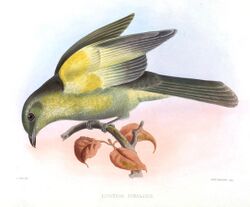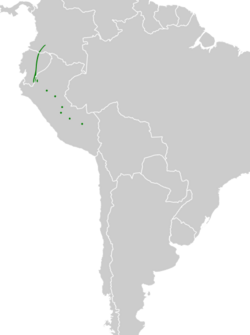Biology:Grey-tailed piha
| Grey-tailed piha | |
|---|---|

| |
| Scientific classification | |
| Domain: | Eukaryota |
| Kingdom: | Animalia |
| Phylum: | Chordata |
| Class: | Aves |
| Order: | Passeriformes |
| Family: | Cotingidae |
| Genus: | Snowornis |
| Species: | S. subalaris
|
| Binomial name | |
| Snowornis subalaris (Sclater, PL, 1861)
| |

| |
| Synonyms | |
|
Lathria subalaris (P.L.Sclater, 1861) | |
The grey-tailed piha (Snowornis subalaris) is a species of bird in the family Cotingidae. It is found in Colombia, Ecuador and Peru where its natural habitat is subtropical or tropical moist montane forests.
Description
The grey-tailed piha grows to a length of about 23 cm (9 in). Both sexes have a dull grey head with a narrow, pale yellow ring of bare skin surrounding the eye. The upper parts are olive-green with a greyish rump and a plain grey tail. The underparts are pale olive green with lighter streaks and a pale grey belly. The underwing coverts are pale yellow. This bird could be confused with the olivaceous piha (Snowornis cryptolophus), but it has a yellower belly and an olive rather than a grey tail.[2]
Distribution and habitat
The grey-tailed piha occurs on the eastern slope of the Andes range, in southern Colombia, Ecuador and Peru at altitudes between about 600 and 1,400 m (2,000 and 4,600 ft). It is generally a rare or uncommon bird and is found in the middle and lower parts of the canopy. It is an elusive bird, remaining still for long periods and blending in with the branches. It is usually solitary, but may occasionally join a mixed species foraging group. It feeds mainly on insects, but may also consume fruits, sometimes flying out from its perch, where it sits unmoving for long periods, to catch an insect in the air or hover to glean insects from foliage.[2]
Status
Because of current and future deforestation in the Amazon Basin, the population is expected to decline by 25-30% over the next three generations, causing this species to be listed as near threatened.[3]
References
- ↑ BirdLife International (2020). "Snowornis subalaris". IUCN Red List of Threatened Species 2020: e.T22700831A180886702. doi:10.2305/IUCN.UK.2020-3.RLTS.T22700831A180886702.en. https://www.iucnredlist.org/species/22700831/180886702. Retrieved 15 November 2021.
- ↑ 2.0 2.1 Ridgely, Robert S.; Tudor, Guy (2009). Field Guide to the Songbirds of South America: Vol. II, The Suboscine Passerines. University of Texas Press. p. 762. ISBN 978-0-292-71748-0. https://books.google.com/books?id=_y4FMhURra0C&pg=PA762.
- ↑ http://www.birdlife.org/datazone/speciesfactsheet.php?id=4494
Wikidata ☰ Q1921529 entry
 |


